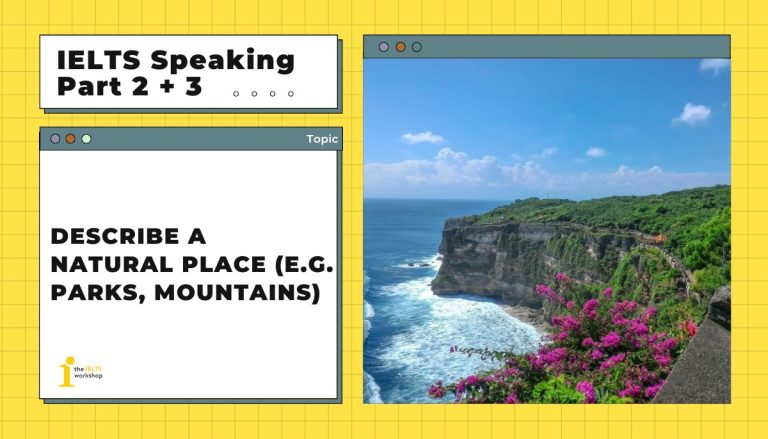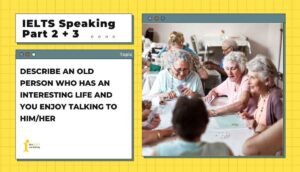Trong bài giải mẫu lần này, cô Thu Thuỷ của The IELTS Workshop sẽ hướng dẫn bạn trả lời topic “Describe a natural place (e.g. parks, mountains)“ trong IELTS Speaking Part 2. Cùng tham khảo sample, từ vựng và một vài cách diễn đạt ghi điểm trong phần thi IELTS Speaking nhé.
Part 2: Describe a natural place (e.g. parks, mountains)
Describe a natural place (e.g. parks, mountains)
You should say:
Where this place is
How you knew this place
What it is like
And explain why you like to visit it
Dưới đây là bài mẫu cho topic “Describe a natural place (e.g. parks, mountains)“.
1. Bài mẫu (Sample)

2. Từ vựng (Vocabulary)
- Botanical Gardens: Vườn Bách Thảo
- lush: tươi tốt
- vibrant green space: không gian xanh tươi
- hustle and bustle: sự nhộn nhịp và hối hả
- serene: thanh bình
- picturesque: đẹp như tranh
- stroll: đi dạo
- golden glow: ánh sáng vàng
- enchanting: mê hoặc, quyến rũ
- appreciate: trân trọng, thưởng thức
- soothing sounds: âm thanh êm dịu
- profound: sâu sắc
- peace and tranquility: sự bình yên và tĩnh lặng
Part 3:
Bên cạnh Part 2, bạn hãy tham khảo thêm Part 3 cho chủ đề này nhé
What kind of people like to visit natural places?
What are the differences between a natural place and a city?
Do you think that going to the park is the only way to get close to nature?
What can people gain from going to natural places?
Are there any wild animals in the city?
Do you think it is a good idea to let animals stay in local parks for people to see?
1. What kind of people like to visit natural places?
People who enjoy visiting natural places often have a deep appreciation for the outdoors and nature. This includes nature enthusiasts, hikers, bird watchers, and those who seek a break from the hustle and bustle of urban life. Additionally, individuals who are concerned about their mental and physical well-being might prefer natural settings to relax, and exercise. Families with children also enjoy these places as they provide a safe and enriching environment for outdoor activities and learning.
- deep appreciation: sự trân trọng sâu sắc
- nature enthusiasts: những người đam mê thiên nhiên
- mental and physical well-being: sức khỏe tinh thần và thể chất
- enriching environment: môi trường phong phú
2. What are the differences between a natural place and a city?
The primary difference between a natural place and a city is the environment. Natural places are characterized by greenery, fresh air, and a sense of tranquility, often including forests, mountains, rivers, and beaches. These areas tend to have less human-made structures and less pollution. Cities, on the other hand, are bustling with buildings, roads, and an extensive infrastructure that supports a high population density. Cities are centers of economic activity, culture, and social interaction but often suffer from noise, air pollution, and a fast-paced lifestyle.
- extensive infrastructure: cơ sở hạ tầng rộng lớn
- high population density: mật độ dân số cao
- fast-paced lifestyle: lối sống nhịp độ nhanh
3. Do you think that going to the park is the only way to get close to nature?
No, going to the park is not the only way to get close to nature. While parks provide a convenient and accessible way for urban dwellers to experience greenery, there are many other options. For example, people can visit nature reserves, hiking trails, beaches, mountains, and forests. Gardening or keeping indoor plants can also bring a touch of nature into one’s home.
- urban dwellers: Cư dân thành phố
- nature reserves: Các khu bảo tồn thiên nhiên
4. What can people gain from going to natural places?
People can gain numerous benefits from visiting natural places. Firstly, it provides a break from the stress and noise of daily life, promoting mental relaxation and well-being. Exposure to nature has been shown to reduce stress, anxiety, and depression. Physically, natural places offer opportunities for exercise, such as walking, hiking, or swimming, which improve overall health.
- Exposure to nature: Tiếp xúc với tự nhiên:
5. Are there any wild animals in the city?
Yes, there are wild animals in the city, though they are often less visible than those in natural areas. Common urban wildlife includes birds, such as pigeons and sparrows, as well as squirrels, and foxes. Additionally, various insects and smaller creatures thrive in urban environments.
- Sparrows: chim sẻ
6. Do you think it is a good idea to let animals stay in local parks for people to see?
It can be a good idea to allow animals to stay in local parks for people to see, as it provides an opportunity for urban residents to connect with wildlife and learn about nature. However, this needs to be managed carefully to ensure the safety and well-being of both the animals and people. In some cases, particularly with larger or potentially dangerous animals, it might be better to have dedicated wildlife reserves or sanctuaries.
- dedicated wildlife reserves: Khu bảo tồn động vật hoang dã chuyên biệt
- sanctuaries: khu bảo tồn
Bài mẫu bởi Cô Thu Thuỷ – Giáo viên The IELTS Workshop
Các bạn có thể tham khảo Bộ đề dự đoán IELTS Speaking của The IELTS Workshop để ôn tập những chủ đề mới cho kỳ thi IELTS sắp tới của mình nhé!
Nếu bạn muốn nhận Mentor 1-1 để hoàn thiện kĩ năng Speaking của mình trước khi bước vào kỳ thi, tham khảo ngay Khóa bổ trợ từng kỹ năng IELTS của The IELTS Workshop.









